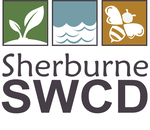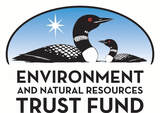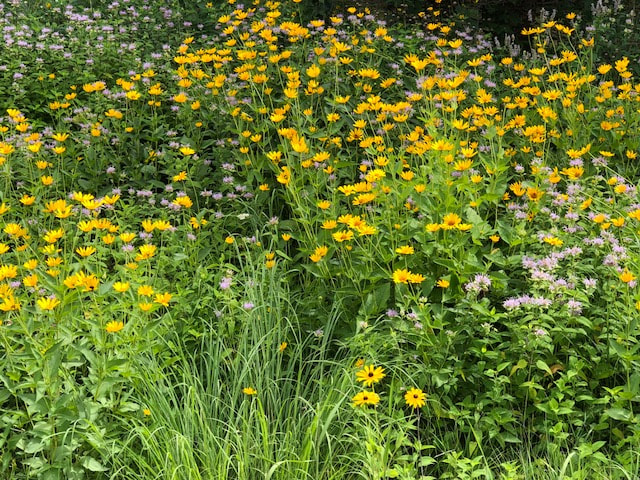A little history on Grams County Park
|
Grams County Park was acquired in 2002 from Howard and Marvel Grams, the park preserves their commitment to community, family and the provision for future generations. Covering well more than 100 acres, this property affords nearly 2 miles of trails and boardwalk that take visitors through open natural space, various wetland types, tamarack bog and lush oak forest. The steep topography offers scenic views of Lake Fremont and Blue Hill, 10 miles to the west.
|
HELP Grant
The Sherburne SWCD in partnership with the Sherburne County Parks department received a grant from the Board of Water and Soil Resources (BWSR) in order to restore 24 acres of native prairie habitat at Grams County Park located in Zimmerman. The funding was made possible through an appropriation from the Environmental and Natural Resources Trust Fund (ENRTF). The program is focused on restoring and enhancing diverse native habitat throughout Minnesota to benefit pollinators and other beneficial insects. The project at Grams County Park will consist of a prescribed burn, three conservation grazing sessions using a combination of sheep and goats, and seeding with a diverse mix of native grasses and flowers. The project completion date will be summer of 2023.
How will the HELP grant be use?
Long-term management methods for the Grams County Park prairie restorations including burning, grazing, planting; all are used to maintain floral diversity, remove woody or invasive species and reduce weed growth.
What will the HELP grant involve?
1. Site Assessment— Identify the site characteristics and define goals for the restoration.
2. Vegetation Removal – Remove existing weeds and undesired vegetation from the site to prevent aggressive weedy species from out-competing native prairie plants. This will be achieved through the use of prescribed burning and conservation grazing.
3. Seedbed Preparation – Prepare a seedbed to ensure good seed-soil contact and promote germination of planted seeds.
4. Seeding/Planting – Select seed mixes and seeding methods that are well suited to the site and project goals.
5. Establishment and Aftercare – Control weeds and promote the establishment and growth of prairie plants through the first few years after seeding.
6. Long-term Management – Maintain the health and diversity of native prairie into the future.
What will the HELP grant involve?
1. Site Assessment— Identify the site characteristics and define goals for the restoration.
2. Vegetation Removal – Remove existing weeds and undesired vegetation from the site to prevent aggressive weedy species from out-competing native prairie plants. This will be achieved through the use of prescribed burning and conservation grazing.
3. Seedbed Preparation – Prepare a seedbed to ensure good seed-soil contact and promote germination of planted seeds.
4. Seeding/Planting – Select seed mixes and seeding methods that are well suited to the site and project goals.
5. Establishment and Aftercare – Control weeds and promote the establishment and growth of prairie plants through the first few years after seeding.
6. Long-term Management – Maintain the health and diversity of native prairie into the future.
2022 Time Line
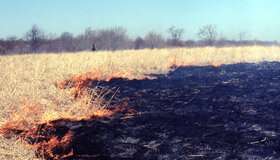
General timeline for the Grams County Park prairie restoration is as follows:
July - Prescribed Fire Burn of the Area
Prescribed fire is a carefully planned and controlled fire conducted to manage natural area. It is conducted only under safe conditions. Fire prevents brush and trees from overtaking the prairie, prevents build-up of dead vegetation that encourages weeds and retards new growth, and improves habitat for prairie birds, mammals and butterflies, many of them endangered.
July - Prescribed Fire Burn of the Area
Prescribed fire is a carefully planned and controlled fire conducted to manage natural area. It is conducted only under safe conditions. Fire prevents brush and trees from overtaking the prairie, prevents build-up of dead vegetation that encourages weeds and retards new growth, and improves habitat for prairie birds, mammals and butterflies, many of them endangered.
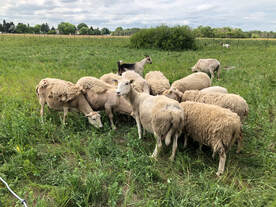
August & September - Conservation Grazing
The HELP grant allocated to Grams County Park will also include the implementation of a Conservation Grazing Program in order to manage the over-grown understories of the park in an ecological way. Utilizing sheep and goats will eliminate the need for herbicide usage, provide targeted vegetation management, reduce unwanted thickets of plants, recycle nutrients, and provide trample seed planting opportunities. Conservation grazing also helps to reduce the quantity of invasive or exotic species,
The HELP grant allocated to Grams County Park will also include the implementation of a Conservation Grazing Program in order to manage the over-grown understories of the park in an ecological way. Utilizing sheep and goats will eliminate the need for herbicide usage, provide targeted vegetation management, reduce unwanted thickets of plants, recycle nutrients, and provide trample seed planting opportunities. Conservation grazing also helps to reduce the quantity of invasive or exotic species,
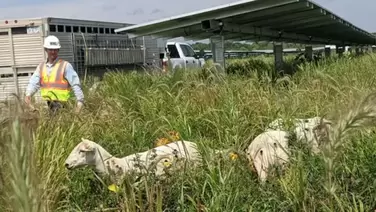
Why is Grams County Park is using Sheep and Goats for conservation grazing?
Sheep
• Effective on large to small scale properties
• Conducive to prairies, savannas and lowland properties
• Ideal for low impact pollinator habitat management
Goats
• Effective on large to small scale properties
• Conducive to prairies, savannas and woodlands
• Ideal for brush control following forestry mowing
How do goats and sheep help restore the prairie?
The grazing goats and sheep are introduced to over-grown understories that need invasive species removal. They eat the leaves they can reach off bushes and reduce the ability of the plant to grow and reproduce. When introduced to browse repeatedly, the grazers deplete nutrient stores in the plant roots to the point that the plant can no longer thrive. We then introduce native seed to create competition for nutrients and water making the invasive species less likely to re-establish in unwanted places.
Sheep
• Effective on large to small scale properties
• Conducive to prairies, savannas and lowland properties
• Ideal for low impact pollinator habitat management
Goats
• Effective on large to small scale properties
• Conducive to prairies, savannas and woodlands
• Ideal for brush control following forestry mowing
How do goats and sheep help restore the prairie?
The grazing goats and sheep are introduced to over-grown understories that need invasive species removal. They eat the leaves they can reach off bushes and reduce the ability of the plant to grow and reproduce. When introduced to browse repeatedly, the grazers deplete nutrient stores in the plant roots to the point that the plant can no longer thrive. We then introduce native seed to create competition for nutrients and water making the invasive species less likely to re-establish in unwanted places.
|
Spring 2023 - Planting
The key to establishing a successful prairie is to maximize seed-to-soil contact during planting. A average of 40 seeds/ per square foot will be sown to reduce risk of weed invasion. Some of the native plants being restored to this area include: Leadplant, Butterflyweed, Wild Lupine, Asters and Goldenrods. The native flowers selected will create a blooming landscape from spring until fall. |
